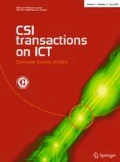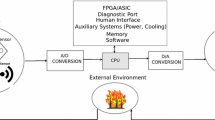Abstract
Internet of Things (IoT) has gained tremendous popularity with the recent fast-paced technological advances in embedded programmable electronic and electro-mechanical systems, miniaturization, and their networking ability. IoT is expected to change the way of human activities by extensively networked monitoring, automation, and control. However, widespread application of IoT is associated with numerous challenges on communication and storage requirements, energy sustainability, and security. Also, IoT data traffic as well as the service quality requirements are application-specific. Through a few practical example cases, this article presents IoT data driven unique communication approaches and optimization techniques to reduce the data handling footprint, leading to communication bandwidth, cloud storage, and energy saving, without compromising the service quality. Subsequently, it discusses newer challenges that are needed to be tackled, to make the IoT applications practically viable for their wide-ranging adoption.






Similar content being viewed by others
References
Lien S, Hung S, Deng D, Wang YJ (2017) Efficient ultra-reliable and low latency communications and massive machine-type communications in 5G new radio. In: Proceedings of IEEE GLOBECOM, pp 1–7
Aijaz A, Aghvami AH (2015) Cognitive machine-to-machine communications for internet-of-things: a protocol stack perspective. IEEE Internet Things J 2(2):103–112
Tomi I, McCann JA (2017) A survey of potential security issues in existing wireless sensor network protocols. IEEE Internet Things J 4(6):1910–1923
Gadde PH, Biswal M, Brahma S, Cao H (2016) Efficient compression of PMU data in WAMS. IEEE Trans Smart Grid 7(5):2406–2413
de Souza JCS, Assis TML, Pal BC (2017) Data compression in smart distribution systems via singular value decomposition. IEEE Trans Smart Grid 8(1):275–284
Gungor VC, Sahin D, Kocak T, Ergut S, Buccella C, Cecati C, Hancke GP (2011) Smart grid technologies: communication technologies and standards. IEEE Trans Ind Inform 7(4):529–539
Cotilla-Sanchez E, Hines PDH, Danforth CM (2012) Predicting critical transitions from time series synchrophasor data. IEEE Trans Smart Grid 3(4):1832–1840
Dong J, Ma X, Djouadi SM, Li H, Liu Y (2014) Frequency prediction of power systems in FNET based on state-space approach and uncertain basis functions. IEEE Trans Power Syst 29(6):2602–2612
Xie L, Chen Y, Kumar PR (2014) Dimensionality reduction of synchrophasor data for early event detection: linearized analysis. IEEE Trans Power Syst 29(6):2784–2794
Ge Y, Flueck AJ, Kim DK, Ahn JB, Lee JD, Kwon DY (2015) Power system real-time event detection and associated data archival reduction based on synchrophasors. IEEE Trans Smart Grid 6(4):2088–2097
Das S, Sidhu TS (2014) Application of compressive sampling in synchrophasor data communication in WAMS. IEEE Trans Ind Inform 10(1):450–460
Khan J, Bhuiyan S, Murphy G, Williams J (2016) Data denoising and compression for smart grid communication. IEEE Trans Signal Inf Process Netw 2(2):200–214
Tate JE (2016) Preprocessing and golomb-rice encoding for lossless compression of phasor angle data. IEEE Trans Smart Grid 7(2):718–729
Loia V, Tomasiello S, Vaccaro A (2017) Fuzzy transform based compression of electric signal waveforms for smart grids. IEEE Trans Syst Man Cybern Syst 47(1):121–132
Tripathi S, De S (2015) Assessment of power system stability using reduced-rate synchrophasor data. In: Proceedings of IEEE ANTS, Kolkata, India, pp 1–5
Tripathi S, De S (2018) Dynamic prediction of powerline frequency for wide area monitoring and control. IEEE Trans Ind Inform 14(7):2837–2846
IEEE standard for synchrophasor data transfer for power systems (2011)’ IEEE Std C37.118.2-2011 (Revision of IEEE Std C37.118-2005), pp 1–53
Tong X, Kang C, Xia Q (2016) Smart metering load data compression based on load feature identification. IEEE Trans Smart Grid 7(5):2414–2422
Wang Y, Chen Q, Kang C, Xia Q, Luo M (2017) Sparse and redundant representation-based smart meter data compression and pattern extraction. IEEE Trans Power Syst 32(3):2142–2151
Abuadbba A, Khalil I, Yu X (2018) Gaussian approximation based lossless compression of smart meter readings. IEEE Trans Smart Grid 9(5):5047–5056
Eichinger F, Efros P, Karnouskos S, Bhm K (2015) A time-series compression technique and its application to the smart grid. VLDB J 24(2):193–218
Ringwelski M, Renner C, Reinhardt A, Weigel A, Turau V (2012) The hitchhiker’s guide to choosing the compression algorithm for your smart meter data. In: IEEE International energy conference and exhibition (ENERGYCON), pp 935–940
Unterweger A, Engel D (2015) Resumable load data compression in smart grids. IEEE Trans Smart Grid 6(2):919–929
Tripathi S, De S (2018) An efficient data characterization and reduction scheme for smart metering infrastructure. IEEE Trans Ind Inform 14(10):4300–4308
Gupta P, Kaushik K, De S, Jana S (2013) Feasibility analysis on integrated recharging and data collection in pollution sensor networks. In: Proceedings of national conference on communication (NCC), pp 1–6
Roychowdhury M, Shukla NK, De S, Biswas R (2018) Energy-efficient air pollution monitoring with optimum duty-cycling on a sensor hub. In: Proceedings of national conference on communication (NCC), pp 1–6
De S, Singhal R (2012) Toward uninterrupted operation of wireless sensor networks. IEEE Comput Mag 45(9):24–30
Mahajan S, Liu H, Tsai T, Chen L (2018) Improving the accuracy and efficiency of PM2.5 forecast service using cluster-based hybrid neural network model. IEEE Access 6:19193–19204
Shaban KB, Kadri A, Rezk E (2016) Urban air pollution monitoring system with forecasting models. IEEE Sensors J 16(8):2598–2606
Gupta V, De S (2018) SBL-based adaptive sensing framework for WSN-assisted IoT applications. IEEE Internet Things J 5(6):4598–4612
Batra N, Gulati M, Singh A, Srivastava MB (2013) It’s different: insights into home energy consumption in India. In: Proceedings of ACM Wksp embedded systems for energy-efficient buildings, pp 3:1–3:8
Acknowledgements
This work has been partly supported by the Department of Telecommunication, Government of India, under the Grant No. 4-23/5G test bed/2017-NT, for building end to end 5G test-bed.
Author information
Authors and Affiliations
Corresponding author
Rights and permissions
About this article
Cite this article
Tripathi, S., De, S. Data-driven optimizations in IoT: a new frontier of challenges and opportunities. CSIT 7, 35–43 (2019). https://doi.org/10.1007/s40012-019-00217-y
Received:
Accepted:
Published:
Issue Date:
DOI: https://doi.org/10.1007/s40012-019-00217-y




